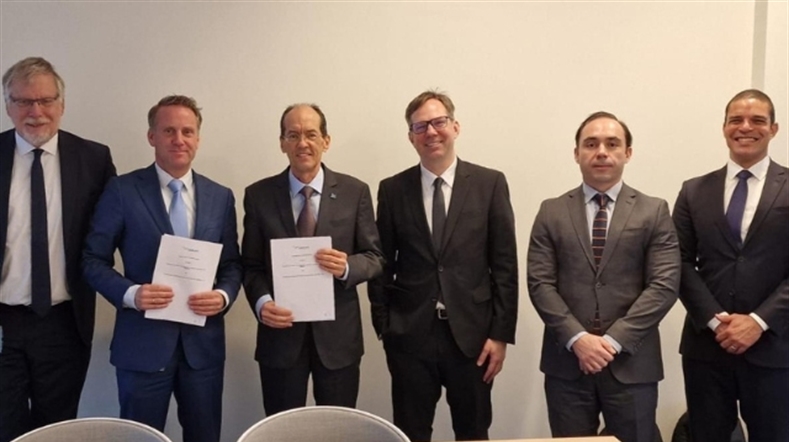Electronic defence
Understanding how to use the electromagnetic spectrum (e.g. localizing transmitters, identifying unknown signals) and how to misuse the electromagnetic spectrum (e.g. jamming communications, falsifying positioning information) is the specialty of TNO's Electronic defence department. With its significant knowledge base, the Electronic defence team provides an operational advantage to our customers.
The combination of the different expertise areas in Electronic Defence is unique in the Netherlands - and can be even considered unique in the world. And when it comes to electromagnetic innovations, our department is the strategic research and technology partner of the Netherlands Ministry of Defence, the Intelligence Services and the Ministry of Justice and Safety. The success of this strategic relationship is the responsibility of Electronic defence. It provides the incentive to guarantee an up-to-date knowledge base, readily available knowledge and development of future capabilities.
Areas of expertise
Electronic defence covers spectrum operations in the electromagnetic environment. This requires knowledge of the entire electromagnetic spectrum. As the essence of our work and the physics involved differ substantially throughout the application domains in the spectrum, the department is divided in four distinct technology cores:
Electromagnetic signatures
An electromagnetic signature of a (military) platform is one of the most important issues with respect to the platform’s detectability (ability to remain undetected) and to its susceptibility (ability to remain hit-free). Signatures are a measure of the (re-)radiated emission in a certain wavelength and have therefore significant importance on detection, classification and identification by adversary sensor systems and on hit probability in a potential engagement phase. For this reason it is important to be have the capability to keep such signatures below safe levels.
Radar electronic warfare
Radar systems have been used in military operations ever since the 1930s. Consequently, armies, navies and air forces have conducted Radar Electronic Warfare to deny, protect against and/or exploit the adversary use of radar systems. Over this period, EW techniques have changed considerably, following and anticipating the evolution of radar systems. Denying the opponent the use of radar systems is a critical factor in gaining information superiority and consequently has severe impact on the situational awareness of the adversary. On the other side of that coin, one’s own situational awareness can be substantially improved by being able to effectively detect, identify and even classify (adversary) radar systems.
Communications electronic warfare
Wireless communication technology continues to leap forward, ranging from civil applications like 4th generation network technologies (such as LTE-Advanced) and WiFi to military datalinks. With an unprecedented number of users, this technology is at the same time enabling the use of radio controlled improvised explosive devices (RC-IEDs), adversary use of GPS and piloting unmanned vehicles (UxVs). In order to ensure a position of information superiority, thereby protecting people, forces and infrastructure, it is important to – on one hand – robustly and securely control these transmissions, and on the other hand, effectively and timely deny them. That is the domain of Communications Electronic Warfare.
Electro-optical systems and warfare
The Electro-optical systems and warfare core approaches Electro-optical (or EO) observation from two opposite perspectives. The Electro-optical systems perspective supports the design and performance analysis of EO observation systems, which cover the chain from electronics and optics in the system, via the propagation through the atmosphere to the objects to be detected in their background.
The EO Warfare technology perspective aims at denying the enemy the use of the EO spectrum while protecting its use by friendly forces. This involves EO countermeasures such as infrared decoys and smokes but also laser countermeasures up to high-energy laser systems.
Example projects (unclassified)
Countering improvised explosive devices
Improvised explosive devices (IEDs), also known as roadside bombs, have been prime cause of deaths and injuries in recent Dutch military missions. Electronic defence makes significant contributions to countering these types of threats. Besides technical efforts to counter radio-controlled IEDs, ground-penetrating radar developments and other route clearance techniques, the department also has a coordinating role in this field. We have been directing and guiding the overarching research on C-IED within TNO, the Netherlands and internationally. Expertise also extends to many other topics explored in collaboration with other TNO groups. These include desensitising explosive materials, using augmented reality for incident response and developing state-of-the-art sensor concepts, such as the Leaky Lens antennas.
Countering drones
Electronic defence conducts research and develops innovative countermeasures by using the electromagnetic spectrum. This can safely and securely counter or mislead the different sensor payloads and control devices of ubiquitous drones. So, when you think of jamming, spoofing and even hijacking a drone, that is what we do!
Invisible submarines
The next generation submarines of the Royal Netherlands Navy heavily rely on their ability to remain unseen for their intelligence operations. Electronic defence is working on technologies to minimize magnetic signatures in order to remain imperceptible to magnetic influence mines or magnetic sensors on maritime patrol vessels, frigates or drones, which is one of the most important ways for a submarine to stay covert.
Spectrum surveillance
When monitoring the spectrum there will be signals that are not known or cannot be easily identified. Research on automatic signal classification algorithms is done in order to tackle this challenge. One of the larger research topics is how to use artificial intelligence to enhance signal processing techniques, in order to separate and classify communication signals. These and other methods are developed for so-called blind signal analysis in order assist our customers in the complex task of spectrum surveillance.
Get inspired
Pioneering on the edge of physics: quantum chips tested faster and faster


How TNO’s Ines Corveira Rodrigues shapes tomorrow's quantum world


Unveiling the future of vapour detection technology


EMBRAPII and TNO signed a Memorandum of Understanding (MoU)


AIVD, CWI, and TNO publish renewed handbook for quantum-safe cryptography


